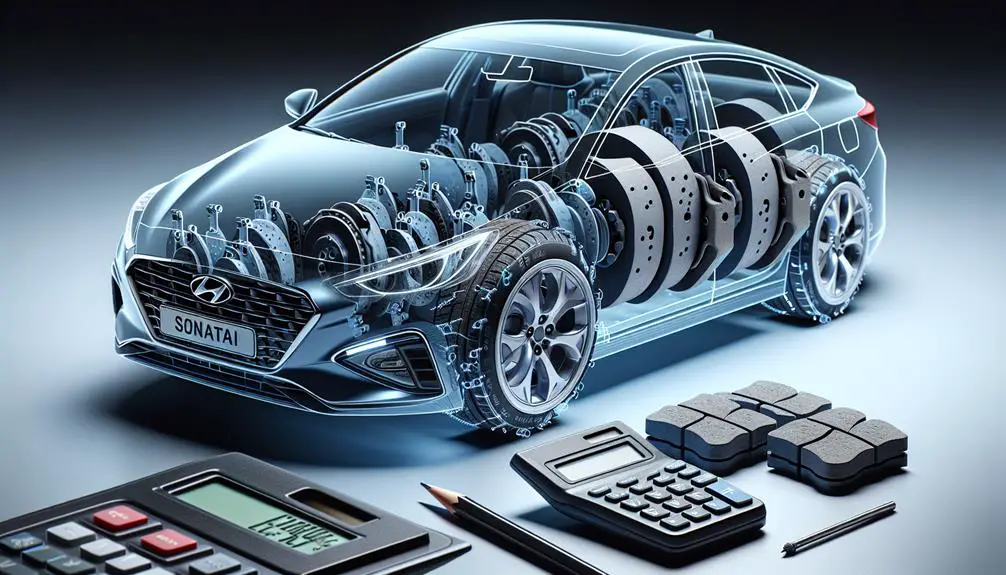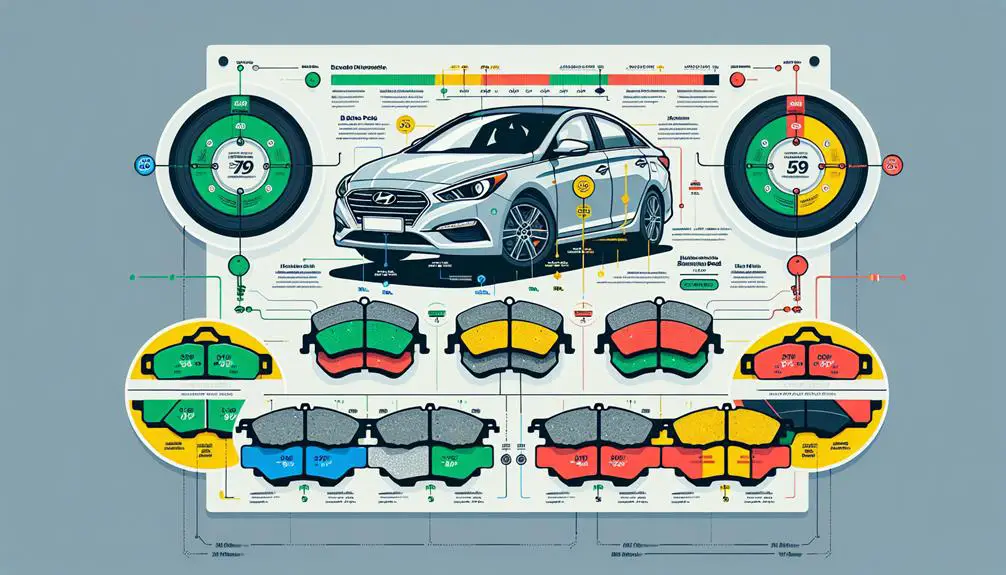The average cost of brake pads for a Hyundai Sonata varies based on factors like the model year, pad quality, purchase location, and installation choice.
This essential maintenance task's price can be influenced by whether you opt for DIY installation or professional service, alongside the type of brake pads you select.
Discovering ways to economize without sacrificing safety involves understanding these cost determinants.
Understanding Brake Pad Costs

Understanding brake pad expenses is vital, as they're a fundamental component of your vehicle's safety system. When you're driving a Hyundai Sonata, knowing what you're likely to spend on brake pads can help you budget for maintenance and avoid surprises. Remember, the cost isn't just a number; it reflects the importance of keeping your car in top condition to guarantee your safety and the safety of others on the road.
You might wonder why there's such a variation in the price of brake pads. It's due to not all brake pads being created equal. They come in different materials, each offering distinct advantages in terms of performance, durability, and noise reduction. Although we're not delving into the specifics of what influences the price in this section, it's worth noting that these factors play a significant role in determining the cost.
For your Hyundai Sonata, you'll find a range of options available, from more affordable to premium choices. It's important to understand that while it might be tempting to go for the cheapest option, this isn't always the wisest decision. Investing in quality brake pads can save you money in the long run by reducing the need for frequent replacements and possibly avoiding damage to other parts of your braking system.
Factors Influencing Price
Several factors influence the price of brake pads for your Hyundai Sonata, including material, brand reputation, and compatibility with your vehicle model. Understanding these factors can help you make an informed decision when it's time to replace your brake pads.
- Material: Brake pads are made from different materials, each offering different levels of performance and durability. Common types include ceramic, semi-metallic, and organic. Ceramic pads generally offer quieter operation and less dust but tend to be pricier. Semi-metallic pads provide excellent performance but may wear down your rotors faster. Organic pads are softer, providing quieter stops but tend to have a shorter lifespan and aren't as effective in extreme driving conditions.
- Brand Reputation: The brand of brake pads can have a significant impact on their price. Well-known brands often charge more because of their reputation for quality and reliability. However, don't overlook lesser-known brands that may offer comparable quality at a more affordable price.
- Compatibility with Your Vehicle Model: Not all brake pads are a one-size-fits-all solution. Certain pads are designed specifically for the braking system of your Hyundai Sonata. These specialized pads may cost more but ensure performance and safety.
- Where You Buy: Prices can vary greatly between retailers. Dealerships typically charge more, while auto parts stores and online retailers might offer competitive pricing. Shopping around can help you find the best deal.
Price Ranges Explained

Understanding the price ranges for Hyundai Sonata brake pads can help you budget more effectively for this important maintenance. Prices vary widely based on several factors including brand, material, and if you're opting for front or rear pads. Let's delve deeper to understand what you might expect to pay.
Brake pads for the Hyundai Sonata typically fall into three main categories: economy, mid-range, and premium. Economy pads are the most affordable but might wear out faster, mid-range pads offer a balance between cost and durability, while premium pads, made from higher quality materials, offer the best longevity and performance but at a higher price.
Here's a simplified breakdown to give you an idea of the price ranges:
| Category | Price Range |
|---|---|
| Economy | $20 – $35 |
| Mid-Range | $36 – $60 |
| Premium | $61 – $90+ |
Economy pads are your go-to if you're on a tight budget and need a quick fix. However, investing in mid-range or premium pads can save you money in the long run, as they generally last longer and perform better, reducing the frequency of replacements.
DIY Replacement Tips
After comprehending the cost implications of different brake pad types for your Hyundai Sonata, let's look at how you can replace them yourself to further save on expenses. Doing your brake pad replacement isn't just about saving money; it's also about comprehending and maintaining your vehicle better.
Here's a simplified guide to help you through the process:
- Gather Your Tools and Parts: Before you start, make sure you have all the necessary tools and the new brake pads ready. You'll need a jack, jack stands, a lug wrench, a socket set, and of course, your new brake pads. Don't forget to wear safety glasses and gloves to protect yourself during the process.
- Remove the Wheel: Use the lug wrench to loosen the lug nuts slightly while the car is on the ground. Then, jack up your Sonata and secure it on jack stands. Remove the lug nuts and wheel to access the brake assembly.
- Replace the Brake Pads: Locate the caliper, and use your socket set to remove it. Be careful not to damage the brake line. Once the caliper is off, the old brake pads should slide right out. Compare them with the new ones to ensure a correct fit before sliding the new pads into place.
- Reassemble and Test: After installing the new brake pads, reattach the caliper and make sure everything is tightened properly. Put the wheel back on, lower the car, and tighten the lug nuts. Before you call it a day, take your Sonata for a test drive to make sure the brakes are functioning correctly, listening for any unusual sounds.
Saving Money on Brake Pads

While replacing your Hyundai Sonata's brake pads yourself can greatly cut costs, there are other strategies you can employ to save even more money on this necessary maintenance task. First, don't wait until the end to buy brake pads. Monitoring their condition and planning ahead allows you to shop around for the best deals, rather than being forced to make a hasty, often pricier, purchase.
You should also consider buying brake pads online. E-commerce platforms often offer competitive prices compared to brick-and-mortar auto parts stores. Just make sure you're purchasing from a reputable source to avoid counterfeit or substandard products. Moreover, look out for sales, discounts, or coupon codes that can slash prices even further.
Comparing prices and quality across brands is another savvy move. While it's tempting to go for the cheapest option, investing in mid-range or higher-quality brake pads can actually be more cost-effective in the long run. They tend to last longer and perform better, which means you won't be replacing them as frequently.
Lastly, don't overlook the value of cashing in on loyalty programs or signing up for newsletters from auto parts retailers. These can offer exclusive discounts or points that add up to savings on future purchases. By combining these strategies with the DIY replacement approach, you'll maximize your savings on brake pads for your Hyundai Sonata without compromising on safety or performance.
Conclusion
To sum up, the price of brake pads for your Hyundai Sonata depends on different factors, including the type and quality you choose. Typically, prices range from $30 to $100, but high-end options can cost more.
You can save money by opting for a DIY replacement if you're handy. Remember, investing in good quality brake pads not only guarantees your safety but also saves you money in the long run by reducing the need for frequent replacements.